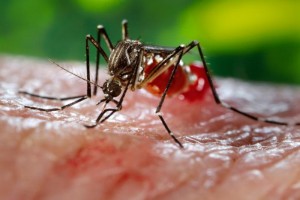Earth Watch Report - Biological Hazards

With a newly-obtained fiery red blood meal visible through her transparent abdomen, the now heavy female Aedes aegypti mosquito took flight as she left her host’s skin surface. (Photo by James Gathany)
Image Source : CDC
.....
| Biological Hazard | French Polynesia | [Statewide] |
| Description | |
| In a follow-up to a story from late November, according to the latest numbers from the French Polynesia Department of Health as of December 3, there has been 99 laboratory confirmed cases and 35,000 suspected cases of Zika fever reported. No hospitalizations or deaths have been reported. Zika fever is an illness caused by a virus that spread through mosquito bites. It is a flavivirus related to yellow fever, dengue, West Nile, and Japanese encephalitis viruses; however, Zika virus (ZIKV) produces a comparatively mild disease in humans. It was first isolated from an infected rhesus monkey in the Zika Forest of Uganda in 1947. Symptoms of Zika fever may include fever, headache, red eyes, rash, muscle aches, and joint pains. The illness is usually mild and lasts 4-7 days. Some experts note that because the virus has spread outside Africa and Asia, ZIKV should be considered an emerging pathogen. ZIKV illness to date has been mild and self-limited, but before West Nile virus caused large outbreaks of neuroinvasive disease in Romania and in North America, it was also considered to be a relatively innocuous pathogen, some experts warn. There is currently no vaccine or medicine to prevent Zika fever. Travelers can protect themselves by preventing mosquito bites. | |
| Biohazard name: | Zika fever |
| Biohazard level: | 2/4 Medium |
| Biohazard desc.: | Bacteria and viruses that cause only mild disease to humans, or are difficult to contract via aerosol in a lab setting, such as hepatitis A, B, and C, influenza A, Lyme disease, salmonella, mumps, measles, scrapie, dengue fever, and HIV. "Routine diagnostic work with clinical specimens can be done safely at Biosafety Level 2, using Biosafety Level 2 practices and procedures. Research work (including co-cultivation, virus replication studies, or manipulations involving concentrated virus) can be done in a BSL-2 (P2) facility, using BSL-3 practices and procedures. Virus production activities, including virus concentrations, require a BSL-3 (P3) facility and use of BSL-3 practices and procedures", see Recommended Biosafety Levels for Infectious Agents. |
| Symptoms: | Symptoms are similar to Dengue fever, but are milder in form and usually last four to seven days. Hemorrhagic manifestations have been documented in only one instance, hematospermia (red–brown fluid in ejaculate). Common symptoms include a maculopapular skin rash that starts on the face or trunk before moving to the rest of the body, conjunctivitis, joint pain, low-grade fevers and headache. |
| Status: | suspected |
35,000 suspected cases of Zika fever reported in French Polynesia

Female Aedes aegypti mosquito
Image/James Gathany
Image/James Gathany
It is a flavivirus related to yellow fever, dengue, West Nile, and Japanese encephalitis viruses; however, Zika virus (ZIKV) produces a comparatively mild disease in humans. It was first isolated from an infected rhesus monkey in the Zika Forest of Uganda in 1947.
.....





No comments:
Post a Comment
Hello and thank you for visiting my blog. Please share your thoughts and leave a comment :)